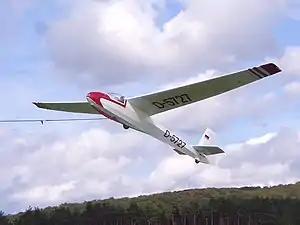Schleicher K 8
The Schleicher K 8 (also known as Ka-8) is a single-seat glider designed by Rudolf Kaiser and built by the Alexander Schleicher company of Germany.
| K 8 | |
|---|---|
 | |
| Role | Sailplane |
| National origin | Germany |
| Manufacturer | Schleicher |
| Designer | Rudolf Kaiser |
| First flight | November 1957 |
| Number built | over 1,100 |
Design and development
The K 8 was derived from the earlier Ka 6 design as a simple single-place sailplane with air brakes using construction techniques similar to the Schleicher K 7, simplified for amateur construction from kits. Emphasis was on rugged construction, good climbing ability in thermals and good handling characteristics.
The prototype K 8 made its first flight in November 1957 and over 1,100 were built in three main versions. The original K 8 had a very small canopy. Side windows for improved visibility were introduced in the next version, and the K 8B, by far the most numerous variant, has a larger one-piece blown Plexiglas canopy. The K 8C features a longer nose, larger main wheel located ahead of the center of gravity and deletion of the larger wooden nose skid resulting in a roomier cockpit.
The cantilever high wings are single-spar structures of pine and plywood, with a plywood leading edge torsion box and fabric covering aft of the spar; the forward sweep is 1° 18' and dihedral is 3°. There are Schempp-Hirth air brakes in the upper and lower surfaces and the wooden ailerons are plywood covered. The cantilever tail unit is of similar construction to the wings, with ply-covered fixed surfaces and fabric-covered rudder and elevators, and a trim tab in the elevator is an optional fitting. The fuselage is a welded steel-tube structure, with fabric covering over spruce longerons and a glass fibre nose cone.
There is a non-retractable and unsprung monowheel, with optional brake, and a nose skid mounted on rubber blocks in front of it, plus a steel skid at the tail.
Operational history
Karl Striedieck of the United States made a 767 km / 476.6 mile ridge flight in a K 8B to establish a world out-and-return record in 1968.
Motor glider variants
A motor glider conversion of the K 8B was developed by LVD (the Flying Training School of the Detmold Aero Club) similar to their conversion of a Scheibe Bergfalke IV known as the BF IV-BIMO, in which a Lloyd LS-400 piston engine mounted in the fuselage drives a pair of small two-blade pusher propellers rotating within cutouts in each wing near the trailing edge.
Another motorglider conversion was used by "Vestjysk Svæveflyveklub" in Denmark: it had a small Wankel rotary engine mounted in a nacelle on an aluminium stick above the main spar. The engine was started with a recoil starter like a lawn mower. The high RPM of the device made it extremely unpopular: the propeller tips created a permanent sonic boom, that made the plane extremely noisy. The harassed citizens of Esbjerg nicknamed the plane 'the flying circular saw' and the engine was removed.
Specifications (K 8B)

Data from [1] The World's Sailplanes:Die Segelflugzeuge der Welt:Les Planeurs du Monde Volume II[2]
General characteristics
- Crew: 1
- Length: 7 m (23 ft 0 in)
- Wingspan: 15 m (49 ft 3 in)
- Wing area: 14.15 m2 (152.3 sq ft)
- Aspect ratio: 15.9
- Airfoil: Root: Göttingen 533 16.7%,Mid: Göttingen 533, Tip: Göttingen 532
- Empty weight: 191 kg (421 lb)
- Gross weight: 310 kg (683 lb)
Performance
- Stall speed: 55 km/h (34 mph, 30 kn)
- Never exceed speed: 200 km/h (120 mph, 110 kn)
- Rough air speed max: 130 km/h (81 mph; 70 kn)
- Aerotow speed: 130 km/h (81 mph; 70 kn)
- Winch launch speed: 100 km/h (62.1 mph; 54.0 kn) (60kn with Tost blue cable weak link)
- Terminal velocity: with full airbrakes 207 km/h (129 mph; 112 kn)
- g limits: +4 -2 at 151 km/h (94 mph; 82 kn)
- Maximum glide ratio: 27 at 73 km/h (45 mph; 39 kn)
- Rate of sink: 0.67 m/s (132 ft/min) at 60 km/h (37 mph; 32 kn)
- Wing loading: 21.8 kg/m2 (4.5 lb/sq ft)
See also
Aircraft of comparable role, configuration, and era
Related lists
Notes
- Taylor, John W. R. (1966). Jane's All The World's Aircraft 1966–67. London: Sampson Low, Marston & Company. pp. 393–394.
- Shenstone, B. S.; K.G. Wilkinson (1963). The World's Sailplanes:Die Segelflugzeuge der Welt:Les Planeurs du Monde Volume II (in English, French, and German) (1st ed.). Zurich: Organisation Scientifique et Technique Internationale du Vol a Voile (OSTIV) and Schweizer Aero-Revue. pp. 34–36.
References
- Taylor, John W. R. (1966). Jane's All The World's Aircraft 1966–67. Londonpages=393-394: Sampson Low, Marston & Company.
{{cite book}}: CS1 maint: location (link) - Shenstone, B.S.; K.G. Wilkinson (1963). The World's Sailplanes:Die Segelflugzeuge der Welt:Les Planeurs du Monde Volume II (in English, French, and German) (1st ed.). Zurich: Organisation Scientifique et Technique Internationale du Vol a Voile (OSTIV) and Schweizer Aero-Revue. pp. 34–36.
External links
- Schleicher Web Site
- Sailplane directory Dead Link
- Another site with Production History.